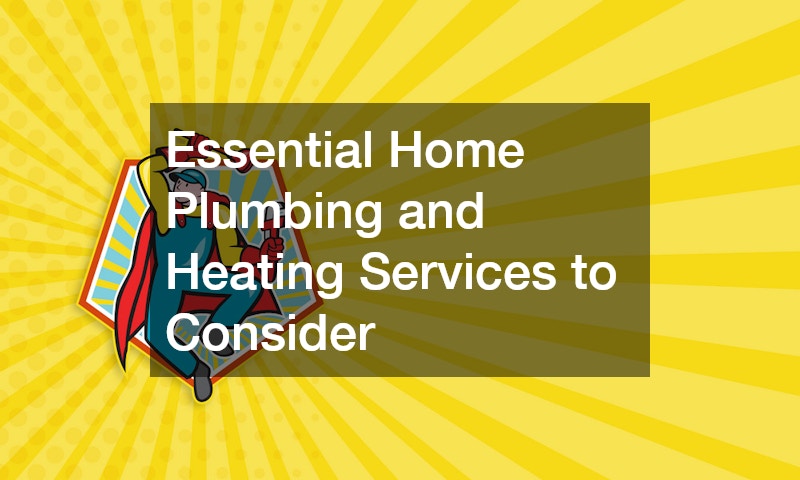As a homeowner, there is a lot that you need to learn and implement when it comes to heating, ventilation, and air conditioning (HVAC) systems. The home HVAC basics cover everything, including how the HVAC system works, how to hire a reliable HVAC company, how to install property, and the benefits of having a well-maintained HVAC system for your property.
The HVAC system has parts like air conditioners, thermostats, furnaces, and ductwork, among other things. In general, the HVAC system works by regulating the outdoor and indoor air to keep your home cool or warm for your comfort preferences. Additionally, HVAC systems also keep humidity levels healthy, filter the air inside, and help save energy.
How to Find a Great HVAC Company
There are several factors to consider when searching for an HVAC company. First, check the company’s credentials and experience. The HVAC system is complicated and expensive, so it should only be installed or fixed by a licensed contractor. A license shows that the HVAC company has the certified knowledge, skills, and experience to do any job safely and correctly.
Other important aspects that you should consider when looking for the best HVAC company are training and experience. The HVAC technicians need proper training to calculate HVAC costs, and help homeowners find the right solution when choosing energy-efficient HVAC systems. On the other hand, experience is also paramount because, as the HVAC technicians handle more projects, they harness their skills and ensure that all work that involves the home HVAC basics is done to last long and to serve as expected.
Undeniably, most people still start searching for a reliable HVAC company by asking their friends and neighbors for recommendations. That is why word-of-mouth advertising is the most effective method for locating excellent local HVAC contractors. Online referrals also help homeowners choose HVAC contractors based on their past performance. As you read through online reviews and ask for referrals, please consider the company’s experience, technological advancements, and whether they offer home HVAC basics evaluations. The selected HVAC company should be able to determine the need for your HVAC system based on your home’s location, size, and the type of HVAC system you need.
The Installation Process for HVAC Equipment
A trained HVAC technician will typically follow a series of steps to ensure that HVAC installation is correct and suits the needs of your home HVAC basics. Assessing your requirements is the initial phase of HVAC installation. Your technician should take into account the climate in your area as well as any family-specific needs. For example, if you live in a humid area, they will suggest that you get a dehumidifier to lower the humidity in your home. If anyone in your family has allergies or asthma, the HVAC installer should suggest ways to improve air quality.
The proper measurement of the new system is an additional crucial phase. Installing a unit that is either too large or too small can result in inefficiency, higher energy costs, and premature system wear and tear. Your technician should calculate the load to determine the unit size that is perfect for your home. Ultimately, know home HVAC basics when it comes to energy efficiency, such as the SEER rating for air conditioning units and the HSPF rating for heat pumps.
During HVAC installation, your technician must inspect the ductwork and refrigerant lines. Any damage to the ductwork must be rectified and sealed. Furthermore, any obstructions or residues must be removed to ensure proper airflow. Check for breaches in the refrigerant lines and replace them as necessary. Once the installation is done, the technician should do a final check to ensure the system works correctly. Remember to request basic maintenance manuals and expert maintenance schedules.

How a Whole-Home Air Conditioner Works
A central air conditioner operates on the principle that any expanding gas cools. This principle applies to all types of air conditioning systems, such as central air conditioning systems, window air conditioners, portable air conditioners, and ductless air conditioners. Generally, the air conditioning system comprises five parts that work together to remove the house’s heat. These components comprise the refrigerant, compressors, condenser, expansion valve, and evaporator coil.
The air conditioner’s refrigerant is the substance that circulates through the cooling tubes as it changes from gas to liquid. It extracts heat from your home and expels it outside. On the other hand, the compressor that pumps refrigerant through all refrigeration components in a large copper loop. After leaving the compressor, the refrigerant travels to the condenser, which is cooled by passing through condensing coils.
Refrigerants will cool and change from hot vapor to a hot liquid at high pressure. The hot liquid will move to the expansion valve, which causes the refrigerant gas to expand, allowing it to cool the air by expelling its heat. Finally, the low-pressure cold liquid leaving the outdoor expansion valve travels indoors to the evaporator coil, which absorbs heat from the warmer air inside your home. It will subsequently cool the air circulating across the coil. The cooled air is then circulated through the ductwork, where the refrigerant begins to boil and transform from a cold liquid to a warm vapor, initiating the cycle again.
What Typically Goes Wrong With Air Conditioners
Air conditioners create a suitable indoor environment in households and workplaces by removing heat and humidity. However, problems with air conditioning can contribute to discomfort, higher energy expenses, and the need for frequent air conditioning repair.
Low refrigerant is one of the primary causes of air conditioner problems. Defects in the refrigerant lines can cause refrigerant deficiency, rendering the air conditioner ineffective at cooling the air. Leak repair is a complex procedure requiring an HVAC technician’s expertise. Freezing evaporator coils is another air conditioner problem that is caused by ventilation issues. Ice may form if the evaporator coil becomes too frigid, and the air conditioning supply registers may produce tepid or no air.
Dirty condenser coils are also a problem in cities, where soot and pollution can block the outdoor units. This accumulation impedes heat transmission, causing the air conditioner to work harder, wear out quicker, and possibly fail. Fan issues caused by a defective motor, lack of lubrication, worn belts, or excessive grime and residue can lead to poor ventilation and air conditioner issues.
Other common causes of air conditioner problems include leakage ducts, improperly calibrated thermostats, and clogged drains. You can prevent air conditioning issues by replacing filthy air filters, inspecting and repairing any holes in conduits, installing a programmable thermostat, removing brush and residue around the outdoor unit, and scheduling routine maintenance with an HVAC professional.
It is possible to prevent air conditioning problems by taking simple measures, such as performing routine maintenance and monitoring for common issues. You also need to master the home HVAC basics. However, if you experience severe problems with your air conditioning system, contact a technician for diagnosis and repair.

Signs Your Air Conditioner Needs Repairs
Your air conditioner requires routine maintenance and repair services to operate effectively like any other household appliance. It’s also essential to watch out for air conditioner warning signs at all times to know when it needs immediate servicing maintenance and to prevent potential failures or higher expenses.
Warm air escaping from your home’s ventilation system indicates that your air conditioning system is failing. Compressor issues or restricted ventilation could be the cause. Secondly, insufficient ventilation is another common indicator of an inefficient air conditioning system. A clogged air filter or a malfunctioning motor could be at fault.
Water seeps around your air conditioner are not normal and could result in significant property damage. Leaks may be caused by a refrigerant problem or a more serious refrigeration system issue. Unusual sounds from your air conditioner may indicate a loose component or a more serious problem.
Finally, call for AC repair services if your air conditioner cycles on and off more frequently than usual. Frequent cycling indicates a problem with the cooling system that a simple tune-up or a complete replacement could solve the problem. High indoor humidity levels can be irritating, and your air conditioner should be able to automatically moderate humidity levels. If not, you must schedule a repair appointment.
How Your Home’s Furnace Works
If you know how your furnace works, that means you master the home HVAC basics and you can easily fix it and avoid expensive repairs. Sometimes, you can solve a problem swiftly on your own. Furthermore, knowing how your furnace works will guide you to show the HVAC technician what’s wrong, saving time and HVAC inspection costs.
The primary components of your furnace include the controls (thermostat and power switches), gas valves, burners, heat exchangers, compressor, duct, ventilation system, and heat exchanger. When your thermostat detects a decline in air temperature below the desired level, it transmits a signal to the furnace, causing the gas valve to open and the burner component beneath the combustion chamber to ignite.
Heat from the burner component warms the metal heat exchanger, which causes heat to circulate through the exchanger’s looped tubes to transfer heat to the air. The blower motor and fan convey the heat through the plenum and the rest of the home’s ductwork. You are kept warm by the heat that travels through the vents. When sufficient heat is produced, the thermostat will turn off the heater.

Why Many Homeowners Love Propane Furnaces
Propane gas furnaces are gaining popularity among householders in the United States due to their efficiency, cost savings, and safety. In some regions, high-efficiency propane furnaces with an Annual Fuel Utilization Efficiency (AFUE) rating of at least 90 are the most frequently installed systems in newly constructed residences. These systems provide comfort and energy savings at a lower cost than other heating options. In regions where coal-fired power facilities generate electricity, propane furnaces emit 22% fewer greenhouse gases than electric heat exchangers.
According to research, propane furnaces save homeowners $300 to $800 annually compared to standard efficiency units. New furnaces can have AFUE ratings as low as 78. However, without routine maintenance, they can lose up to 1% of their efficacy annually. For optimal efficiency, HVAC contractors must size the furnace repair service to the actual heating burden of your home. They can perform a Heat Load Calculation that considers home HVAC basics alterations, such as additions, an updated basement, or additional attic insulation.
The Benefits of Using Fuel Oil
When it comes to home heating, you have various options, including natural gas, electricity, propane, and heating oil. Nevertheless, each has its benefits and limitations. Heating oil, also known as fuel oil, is readily available, which is one of its advantages. It can be delivered anywhere, making it a good option for those living in rural areas without access to natural gas.
In addition, the efficacy of heating oil is quite significant. It produces a large quantity of heat while utilizing a small amount of fuel, making it more efficient than electricity, natural gas, and propane. Furthermore, heating oil is safe because it’s non-explosive and burns cleanly, making it an eco-friendly alternative that does not contaminate groundwater and the air with greenhouse gasses in the event of leakage or spills.

Why Heat Pumps Are Better Than Most Older HVAC Equipment
Heat pumps are central HVAC systems that are more energy-efficient than most older HVAC systems. Heat pumps cool a home’s interior by transferring heated air from the interior to the exterior. During the winter, the heat pump extracts heat from the outside air and transfers it into the residence. They are efficient, cost-effective, and environmentally beneficial home heating methods because they use electricity to warm your home.
There are some limitations to heat pumps. They are unsuitable for locations with extremely low temperatures that drop below zero. In addition, the heat exchangers can’t operate without electricity, and their duration is typically shorter than that of a furnace due to their year-round use.
Air conditioners are a second option for HVAC but are distinct from heat pumps. They compress and expand a refrigerant to remove heat within a room. The refrigerant is cooled and condensed under pressure before being blown into overheated air, a procedure that happens repeatedly. In contrast to heat pumps, air conditioners don’t circulate heated air back into a residence for heating purposes. Finally, when it comes to the pricing of an air conditioner, it’s lower than that of a heat pump, but its operating costs may be higher.
When to Get an HVAC Inspection
As a homeowner who understands all the home HVAC basics, it’s important to know when to schedule an HVAC inspection to prevent potential safety hazards and save money over time. It will also keep your HVAC working in excellent condition. The optimal time for an HVAC inspection is just before you need it the most, particularly during the peak season of use. Remember also that a professional must inspect standard furnaces and air conditioners annually. However, if you use your HVAC system frequently, you may require more than one annual inspection. Additionally, regular servicing should be performed every six months to ensure optimal performance.
Typical HVAC inspection procedures include air filter checks, thermostat calibration and testing, equipment condition testing, refrigerant pressure tests, testing clearances and venting, safety equipment control tests, gas and air pressure tests, coolant level and pressure checks, and efficiency and safety checks. Depending on the condition of your HVAC system, your home inspector may conduct additional or fewer tests. Check with your HVAC service provider to determine what their inspection will entail.
Don’t ignore your home’s HVAC inspection because of the scary costs. Well, depending on the condition of your HVAC system, an HVAC inspection service will cost between $200 and $500. Although this price may seem expensive, it’s significantly less than the cost of HVAC replacement and larger repairs. Consider having regular inspections to lower repair expenses and prevent potential safety hazards.
In conclusion, the home HVAC basics discussed above are paramount. It will help you create a comfortable home that is everyone’s desire. For optimal performance of your HVAC system, always engage with the best HVAC company. Professional HVAC inspectors will also help identify HVAC issues before they become more complicated. All the bets as you work to achieve continuous comfort and ultimate safety for your home.



